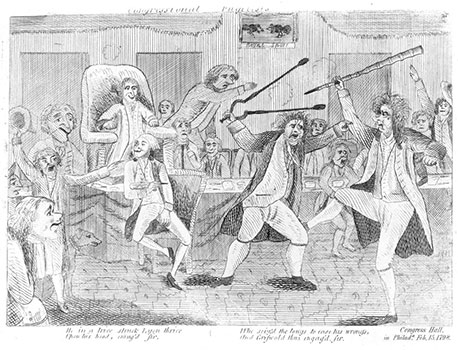Introduction
Conflict in Congress
Analyze the image below. What are the men doing? Look at the setting and the clothing. Where do you think the event took place? Why do you think they are fighting? Do you think the division between political parties got better or worse during John Adams's administration? Read on for clues to the event taking place.

- Notice the men are well-dressed and, perhaps, wearing wigs like important leaders of the time.
- Notice the room looks very formal, like a large meeting room or courtroom.
- This anonymous engraving is called Congressional Pugilists, 1789. A pugilist (pronounced 'pew-ja-list') is a boxer.
In a democracy, disagreement doesn't mean disloyalty. But political parties were new in the United States, and it took time to accept the idea that opposition can strengthen a democratic society. Remember, Congress was divided into opposing political parties: Federalists (often viewed as aristocratic) versus Democratic-Republicans (the party of the common man). Debates between the two groups frequently led to strong words — and, on rare occasions, physical altercations!
In preparation for war, the Federalists passed a series of "Alien and Sedition Acts," providing for the deportation of enemy aliens and fining people who criticized the government. Republicans believed that the sedition acts had the political purpose of silencing their party. During a 1798 debate, Vermont Democractic-Republican Matthew Lyon responded to taunts by spitting tobacco juice in the face of Roger Griswold, a Connecticut Federalist. Outraged that the House didn't punish "the spitting Lyon," Griswold took matters into his own hands. He attacked Lyon with a cane. Lyon then grabbed a pair of fire tongs. The two ended up wrestling on the floor of the House! This engraving depicts the chaos.
As we work through this period, keep this timeline open: A New System of Government: Key Events